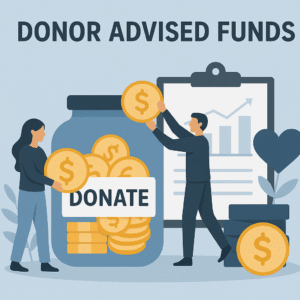After reading hundreds of opinions and articles about donor-advised funds (DAF) being hoarded (yes, I said it!) I continue to be dumbfounded.
But let’s back up. If you aren’t familiar, DAFs are charitable giving accounts that donors set up at public charity. Here’s how they work:

The 501(c)(3) public charity serves as a “sponsoring organization,” which manages and administers individual DAF accounts. With DAFs, donors make a charitable contribution and receive an immediate tax deduction. The contributions are then held and invested by the sponsor organization until the donor recommends that the sponsor grants funds from the DAF to support charities.
Why are DAFs appealing to donors? The upfront tax deduction, for one. They also allow donors to have more time to make philanthropic decisions, donate non-cash assets (think real estate, art, collections, etc.), set up multi-year commitments, and more. And they allow donors to get access to a platform to track and simplify contributions across charities.
So what’s the downside? The AFP Foundation for Philanthropy puts it like this:
DAFs have sparked concern, critique, and controversy. … Some believe that allowing donors to give completely anonymously compromises philanthropy’s democratic principles regarding transparency. Nonprofit administrators and fundraisers have expressed concern that DAFs could significantly disrupt donor-organization relationships by adding a third-party intermediary. Organizations have reported some administrative challenges associated with receiving DAF grants, but those that have received the grants also have a more positive perspective on DAFs than those that have not.
But the biggest issue of late is that DAF accounts do not have a federally-mandated payout rate like private foundations do. For some, this has raised questions about whether DAFs are impeding the flow of philanthropic funds to programmatic charities.
Now, I admit to being old school, but a donor’s money is just that: a donor’s money. How much they put into a DAF and how they distribute those funds is up to them—not organizational leaders, not charities, not the institutions that hold and manage that money, nor (let’s hope) the federal government.
The issue isn’t that DAFs aren’t being spent down. It isn’t that the future of government funding for nonprofit organizations is at risk. And it isn’t really that DAFs disrupt the donor-fundraising relationship.
The issue we all should be concerning ourselves with is rather simple: Donors need to be inspired to give, and they need (and want!) resources and guidance to help create a meaningful plan to do “philanthropy.”
During my 30+ years of client work and interaction with donors, I’ve heard the same phrases and complaints from high-net worth donors over and over: “I just don’t know what to do.” “I don’t know what I can expect.” Or, my favorite, “I’ve made a lot of gifts that have seemed to make little difference.”
Your organization serves an important need. It’s why you’re a charity in the first place, right? But simply having needs isn’t a reason for donors to give. If people aren’t giving, DAFs aren’t the problem. Likewise, attacking the vehicle in which many donors are now giving doesn’t solve any problems.
If you’re going to put time and energy into something, stop putting it into complaining about DAFs or calling for government intervention. Instead, let’s focus on actions that will actually make a difference. If people aren’t giving to your organization, it’s because you haven’t inspired them to do so.
So help them. Create resources for fund holders that educate them about your sector and how they can have an impact. Offer insights to institutions that manage DAFs and help them better guide their clients to recommend grants. Talk to your donors about how they can use DAFs more effectively to serve your organization.
As Hank Rosso the Founder of the Lilly School of Philanthropy’s Fund Raising School put it: Fundraising is the gentle art of teaching the joy of giving.
Opinions won’t help anyone. Education and inspiration will go so much further.

